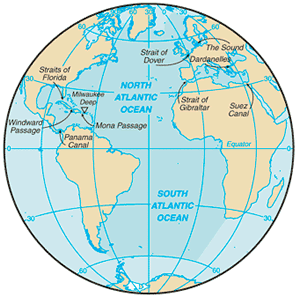The Geography of Atlantic Ocean
The Geography of Atlantic Ocean
Geography
Location: body of water between Africa, Europe, the Southern Ocean, and the Western Hemisphere
Geographic coordinates: 0 00 N, 25 00 W
Map references: Political Map of the World
Area: total: 76.762 million sq km note: includes Baltic Sea, Black Sea, Caribbean Sea, Davis Strait, Denmark Strait, part of the Drake Passage, Gulf of Mexico, Labrador Sea, Mediterranean Sea, North Sea, Norwegian Sea, almost all of the Scotia Sea, and other tributary water bodies
Area - comparative: slightly less than 6.5 times the size of the US
Land boundaries:
Coastline: 111,866 km
Maritime claims:
Climate: tropical cyclones (hurricanes) develop off the coast of Africa near Cape Verde and move westward into the Caribbean Sea; hurricanes can occur from May to December but are most frequent from August to November
Terrain: surface usually covered with sea ice in Labrador Sea, Denmark Strait, and coastal portions of the Baltic Sea from October to June; clockwise warm-water gyre (broad, circular system of currents) in the northern Atlantic, counterclockwise warm-water gyre in the southern Atlantic; the ocean floor is dominated by the Mid-Atlantic Ridge, a rugged north-south centerline for the entire Atlantic basin
Elevation extremes: lowest point: Milwaukee Deep in the Puerto Rico Trench -8,605 m highest point: sea level 0 m
Natural resources: oil and gas fields, fish, marine mammals (seals and whales), sand and gravel aggregates, placer deposits, polymetallic nodules, precious stones
Land use:
Irrigated land:
Natural hazards: icebergs common in Davis Strait, Denmark Strait, and the northwestern Atlantic Ocean from February to August and have been spotted as far south as Bermuda and the Madeira Islands; ships subject to superstructure icing in extreme northern Atlantic from October to May; persistent fog can be a maritime hazard from May to September; hurricanes (May to December)
Environment - current issues: endangered marine species include the manatee, seals, sea lions, turtles, and whales; drift net fishing is hastening the decline of fish stocks and contributing to international disputes; municipal sludge pollution off eastern US, southern Brazil, and eastern Argentina; oil pollution in Caribbean Sea, Gulf of Mexico, Lake Maracaibo, Mediterranean Sea, and North Sea; industrial waste and municipal sewage pollution in Baltic Sea, North Sea, and Mediterranean Sea
Environment - international agreements:
Geography - note: major chokepoints include the Dardanelles, Strait of Gibraltar, access to the Panama and Suez Canals; strategic straits include the Strait of Dover, Straits of Florida, Mona Passage, The Sound (Oresund), and Windward Passage; the Equator divides the Atlantic Ocean into the North Atlantic Ocean and South Atlantic Ocean


